A week before BYD announced its 2017 performance, Wang Chuanfu, the chairman of BYD, visited Baoding, Hebei, and met with Wei Jianjun, the chairman of Great Wall Motors. While both companies remained silent on the details of their meeting, the visit sparked speculation about potential collaboration in the new energy vehicle sector. This move could signal a shift in strategy as both companies navigate an increasingly competitive market.
BYD currently carries a significant number of negative points for average fuel consumption, but it also holds the largest number of new energy vehicle credits in the country—nearly 300,000. It's clear that Wang Chuanfu is looking to leverage these credits strategically.
In the following week, BYD released its 2017 financial report, revealing a revenue of approximately 102.6 billion yuan and a net profit of around 4.066 billion yuan. Despite dominating the global new energy car market with over 110,000 sales for three consecutive years, the company’s profitability declined from the previous year, raising questions about its long-term sustainability.
Since 2014, when the Chinese government began promoting new energy vehicles, BYD emerged as a leader in the field. From 2014 to 2016, its net profit surged from 433 million to 5.052 billion yuan, with a compound annual growth rate of 243%. However, by 2016, the benefits of vertical integration were beginning to wane, and Wang Chuanfu recognized the need for change.
With the reduction of government subsidies and increased competition from new entrants, BYD faced mounting pressure. In response, Wang launched a series of reforms, including decentralizing operations, introducing external suppliers, and opening up platforms for global developers. These changes marked a departure from BYD’s traditional vertical integration model.
Wang Chuanfu emphasized that 2018 would be a pivotal year for BYD, focusing on returning to rapid growth through new energy vehicles and cloud-based solutions. The company also aimed to reclaim lost ground in the traditional fuel vehicle market.
Today, BYD stands at a crossroads, actively breaking down its vertical integration advantages. Wang Chuanfu is acutely aware that companies must adapt or risk being left behind. He hopes BYD can lead the change and evolve into a stronger, more agile new energy company.
In 2017, BYD sold 245,000 traditional fuel vehicles and 110,000 new energy vehicles, totaling 355,000 units. While this number is not exceptional among independent brands, BYD maintained its position as the top seller of new energy vehicles globally for three consecutive years.
The 2017 financial report showed that BYD’s auto business revenue reached 54.5 billion yuan, with new energy vehicles contributing 38.5 billion yuan—an increase of 13.06% compared to the previous year. New energy vehicles remained one of the few bright spots in BYD’s financial performance.
Despite a 19.51% decline in net profit compared to 2016, Wang attributed this to policy changes and increased market competition. Government subsidies accounted for 23.58% of BYD’s operating profit in 2017, highlighting the company’s reliance on support.
According to a research report, although BYD ranks second in market value within the auto industry, its net profit only placed it seventh. The situation worsened in early 2018, with expected profits declining significantly in the first quarter.
However, BYD anticipated a surge in new energy vehicle sales, projecting a more than 200% year-on-year increase. This growth was driven by the success of plug-in hybrid models like the Qin and Song DM, which saw sales jumps of over 500%.
Wang Chuanfu argued that plug-in hybrids should receive greater state support due to their ability to meet double credit requirements and address consumer concerns about range. The recent policy adjustments reduced subsidies for plug-in hybrids and raised thresholds for pure electric vehicles, making it harder for companies to qualify.
In response, BYD introduced new models equipped with advanced battery technology, ensuring continued eligibility for subsidies. Additionally, the company announced plans to spin off its power battery division, aiming to list it independently by 2022-2023.
As competitors like CATL gained momentum, BYD needed to open its battery supply chain to remain competitive. The company is actively seeking external partners and exploring new markets.
Wang Chuanfu has become increasingly aware of the importance of strategic decisions. He emphasized that while product failures can cost millions, strategic missteps can have long-term consequences.
Recent changes in BYD’s business scope indicate internal restructuring, with new divisions focusing on automotive electronics, rail transportation, and more. This marks a shift toward diversification and innovation.
BYD has reorganized its internal structure, granting more autonomy to business groups to improve responsiveness and efficiency. These changes are just the first steps in a broader transformation.
Wang also introduced an open platform for global developers, enabling them to create new applications and services for BYD vehicles. This move aims to counter the growing influence of new energy startups like NIO and XPeng.
Looking ahead, BYD is targeting new profit centers, such as cloud-based solutions and urban rail transit. With projects in 20 cities and several tracks under construction, the cloud business is expected to contribute significantly in 2018.
To regain strength in the traditional fuel vehicle market, BYD plans to boost sales targets and invest in new designs and platforms. The company is also preparing to launch new models with extended ranges, signaling its confidence in the future of the new energy vehicle market.
Photocell Timer Switch Socket
24HR Electronic timer socket with photocell.
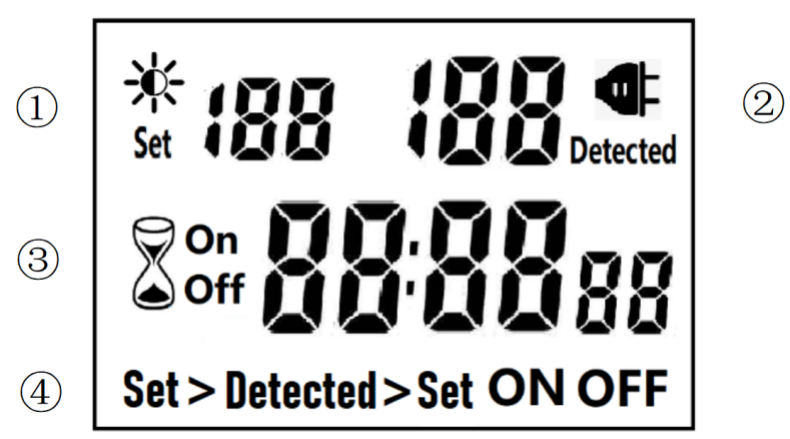
â‘ Light intensity setting
â‘¡ Light intensity detection
â‘¢ Countdown Timer ON & OFF
â‘£ 4 MODES:
Set > Detected: When the light intensity detection value is less than the set value, switch ON or OFF.
Detected > Set: When the light intensity detection value is greater than the set value, switch ON or OFF
ON : Always ON
OFF : Always OFF
NOTED:
1. The light intensity displayed by this machine is not the standard light intensity value (Lux), only the relative light intensity value.
2. The light intensity value is affected by the placement position and direction. Please determine the position first and then set it according to the actual light intensity detected. If you change the position or change the orientation, you need to reset the light intensity setting value suitable for the new position.
3. This product has built-in rechargeable battery. If it is not connected to AC for a long time, you need to connect the power supply to charge until the LCD can display normally.
MANUAL OPERATION
1. Press [UP" or [DOWN" to set the LUX value.
2. Press the [SET" key to start setting, and the P1 settable items will be flashed.
3. Press [UP" or [DOWN" to adjust the value.
4. Press [SET" key again to exit setting or enter next setting for countdown timer.
5. Repeat the [SET" key to start setting, and the P2 & P3 settable items will be flashed.

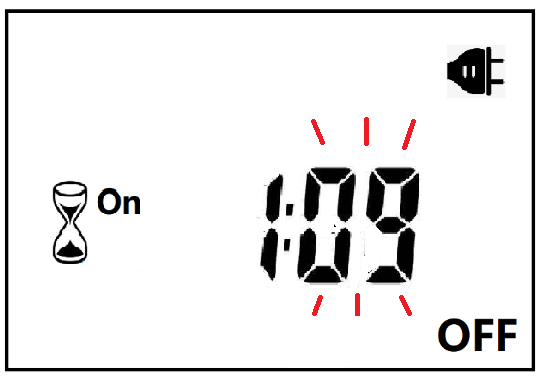

6. Press the [FUN" key to switch the working state in the following:
Set > Detected -> Detected > Set -> ON -> OFF
Set > Detected: Automatically switches when the detected ambient light intensity is darker than the set value
Detected >Set: Automatically switch when the detected ambient light intensity is brighter than the set value
When the brightness meets the setting conditions, the countdown starts as below:
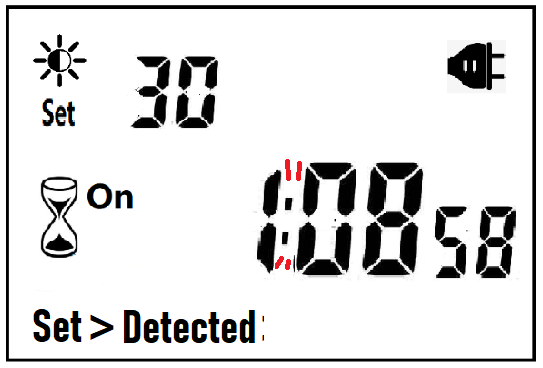
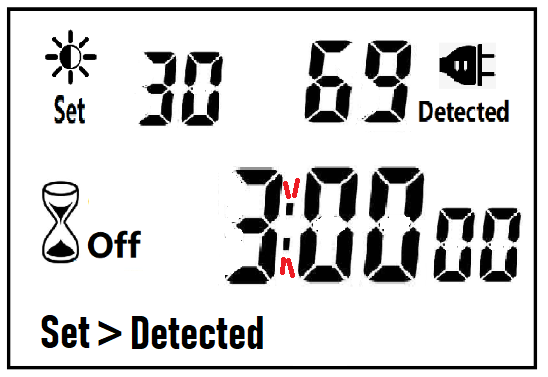
Note:when the countdown is ON, the detected value is not displayed.
When the brightness does not meet the setting conditions, the countdown stops and waits:
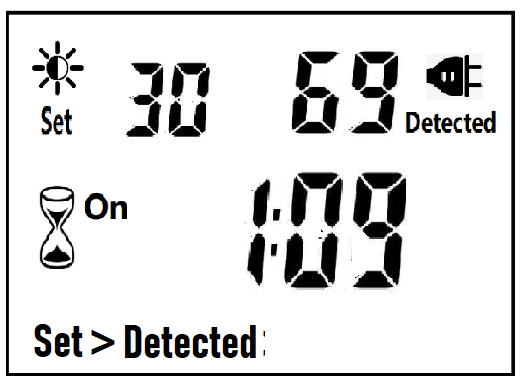
After the countdown ON is reduced to 0, the countdown OFF starts immediately and the power is OFF.
After the countdown OFF is reduced to 0:
A. If the light intensity meets the set conditions, a new round of countdown will be started;
B. If the light intensity does not meet the set conditions, keep the power off and wait for the light to meet the conditions before turning on automatically.
NOTE:
1. If the power is cut off while the countdown is running, the countdown will be terminated immediately and the relay output will be off. After the power is turned on again, a new round of brightness detection will start.
2. Modifying the brightness value in the countdown operation will not affect the current countdown operation. After the off time of the current countdown, the new brightness setting value will take effect.
3. In the countdown on operation, change the setting value of the countdown on, this countdown will still be timed according to the original setting value; the new setting value will take effect when the next countdown on starts.
4. In the countdown off operation, change the setting value of countdown off, this countdown will still be timed according to the original setting value; the new setting value will take effect when the next countdown off is started.
NOTE: the brightness setting value, countdown ON or countdown OFF, any one of which is equal to 0, cannot be switched ON or OFF automatically.
Manual Control
When ON or OFF is displayed, it means that the power supply remains ON or OFF, as shown in the figure below:

Power Detection and Standby Mode
With AC power supply, the icon  lights up and works normally.
lights up and works normally.
When there is no AC power supply, the icon  goes out, the brightness is not detected at this time, and the system enters the standby mode.
goes out, the brightness is not detected at this time, and the system enters the standby mode.
Photocell Timer, Photocell Timer Socket, Photocell Sensor, Photocell Sensor Socket, Sensor Plug, Sensor Switch Socket, Digital Photocell Timer, Digital Sensor Timer
NINGBO COWELL ELECTRONICS & TECHNOLOGY CO., LTD , https://www.cowellsockets.com








![]() lights up and works normally.
lights up and works normally.
![]() goes out, the brightness is not detected at this time, and the system enters the standby mode.
goes out, the brightness is not detected at this time, and the system enters the standby mode.